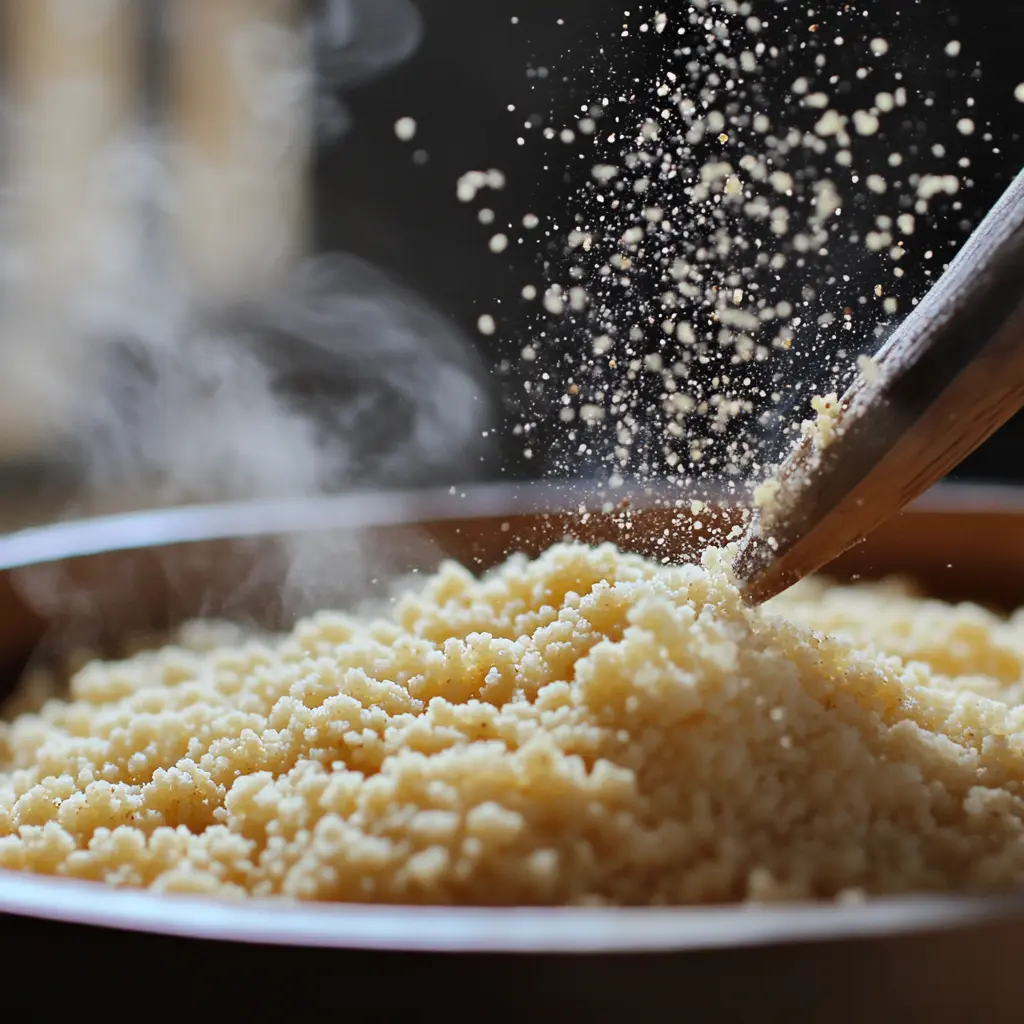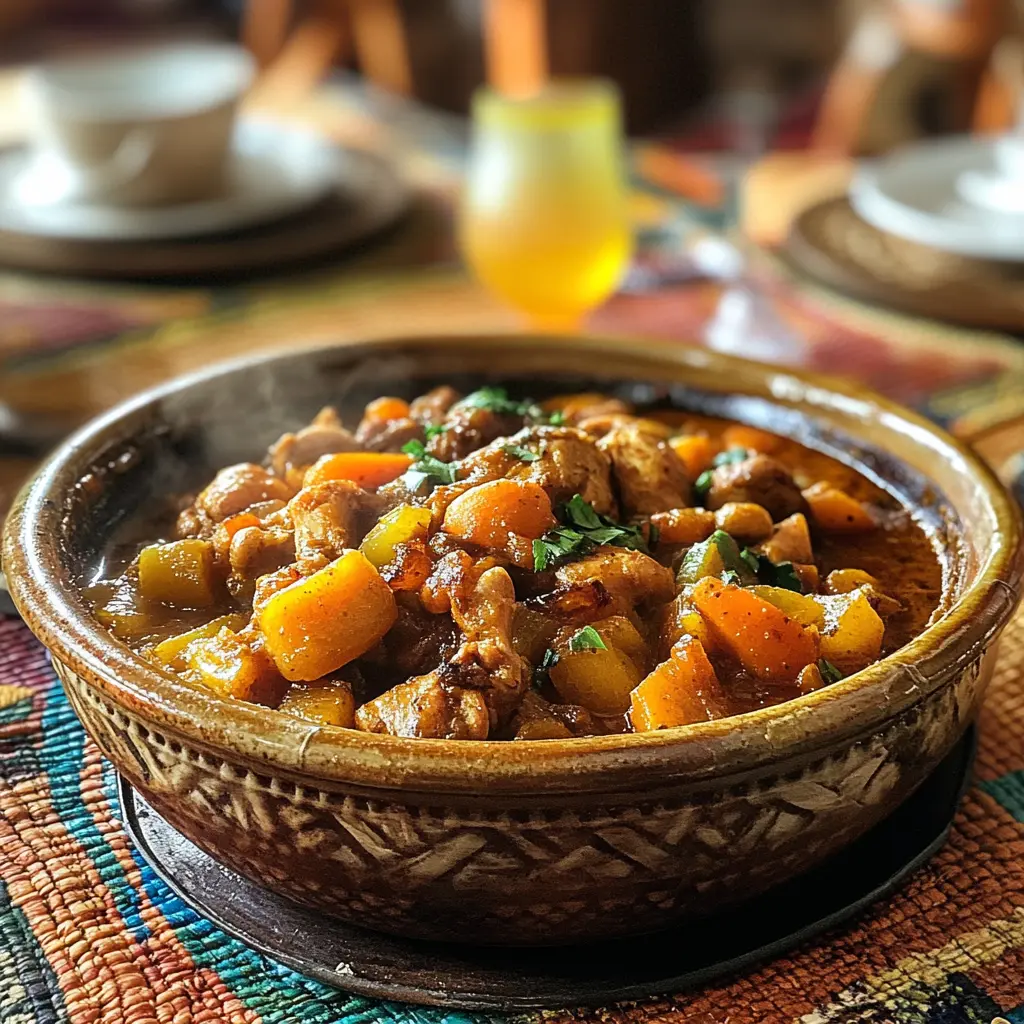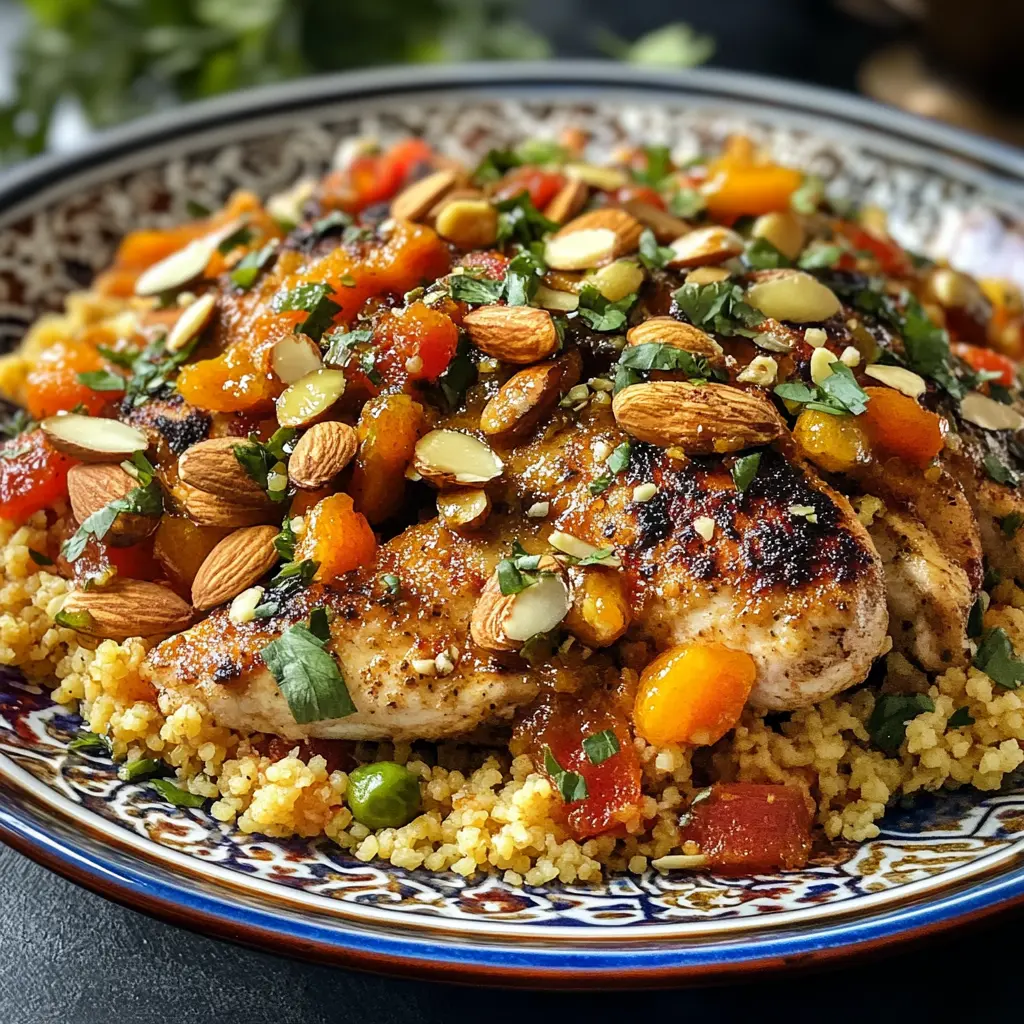Discover the perfect blend of savory and sweet with this authentic Traditional Moroccan Chicken Couscous with Apricot Preserves. This dish is a culinary masterpiece that brings together the rich traditions of Moroccan cooking with a modern twist. It features fluffy couscous as the base, tender chicken simmered with an aromatic blend of spices, and the surprising sweetness of apricot preserves, which ties all the flavors together. Whether you’re preparing a festive meal for loved ones or simply looking to explore a new cultural delicacy, this recipe is guaranteed to delight the senses and transport you to the bustling markets of Marrakech.
Couscous, often referred to as “the national dish of Morocco,” is deeply rooted in the country’s culture and history. Traditionally prepared in large quantities, it’s a dish that symbolizes hospitality, community, and family. On Fridays, a day of communal prayers and gatherings, Moroccan families come together to share a hearty couscous meal. Each region in Morocco has its own unique spin on couscous, incorporating local ingredients and seasonal produce. This version, enriched with apricot preserves, combines the best elements of Moroccan cuisine—sweet, savory, and aromatic—to create a dish that is both comforting and celebratory.
What is Moroccan Couscous?
Moroccan couscous is a traditional North African dish made from steamed semolina grains. It serves as a staple in Moroccan cuisine, offering a versatile base for a wide array of rich and flavorful toppings.
The Importance of Couscous in Moroccan Cuisine
Couscous holds a revered place in Moroccan households. It’s often referred to as “the national dish” and symbolizes family unity and hospitality. This dish frequently appears during Friday family meals and festive occasions.
Key Ingredients and Flavors in Moroccan Dishes
Moroccan cuisine is characterized by a harmonious blend of spices, such as cumin, turmeric, cinnamon, and paprika, combined with ingredients like tender meats, fresh vegetables, and dried fruits. These elements create a culinary experience rich in both taste and aroma.
The Role of Apricot Preserves in Moroccan Cooking
Balancing Sweet and Savory in Moroccan Recipes
Apricot preserves bring a subtle sweetness that complements the bold, earthy spices typical of Moroccan dishes. This balance enhances the complexity of flavors.
Apricots: A Staple in North African Cuisine
Apricots, whether fresh or dried, are widely used in Moroccan cooking. They add a natural sweetness to both savory and dessert recipes, making them an essential ingredient in many traditional dishes.
A Touch of Modern Creativity
Today, chefs across the globe add apricot preserves to dishes inspired by Moroccan traditions, exploring fusion cuisines that honor their roots while embracing innovation. This practice demonstrates the versatility of Moroccan ingredients in culinary creativity.
Why This Dish is a Cultural and Culinary Gem
Tradition and Festivity: Couscous in Celebrations
Couscous is more than just a dish; it’s a celebration of Moroccan heritage. Often served during weddings, Eid, and other cultural festivities, it symbolizes community and joy.
The Blend of Aromatic Spices and Sweet Notes
The fusion of spices with the sweetness of apricot preserves creates a dish that’s both unique and universally appealing, showcasing the essence of Moroccan cuisine.
International Recognition of Couscous
Traditional Moroccan Chicken Couscous with Apricot Preserves has garnered international acclaim, being recognized by UNESCO as an Intangible Cultural Heritage of Humanity. This acknowledgment highlights the cultural and culinary significance of couscous across the Mediterranean region.
Essential Ingredients for Traditional Moroccan Chicken Couscous With Apricot Preserves
Chicken: Choosing the Right Cuts
Opt for bone-in chicken thighs or drumsticks for the best flavor and tenderness. These cuts absorb the spices beautifully during cooking.
Couscous: Types and Variations
Traditional Moroccan couscous is made from semolina and has a light, fluffy texture. Choose fine-grain couscous for authentic results.
Apricot Preserves: Store-Bought vs. Homemade
While store-bought apricot preserves work well, homemade preserves bring a fresher and more vibrant flavor to the dish.
Spices: Cumin, Turmeric, Cinnamon, and Paprika
These spices are the backbone of Moroccan flavors, offering warmth, depth, and complexity to the recipe.
Vegetables: Carrots, Zucchini, Chickpeas, and Raisins
A mix of colorful vegetables adds nutrition and texture, while chickpeas and raisins provide a hint of sweetness.
Herbs and Garnishes
Adding herbs like parsley or cilantro and garnishes such as slivered almonds or sesame seeds elevates the dish visually and adds an extra layer of texture and flavor.
Preparing the Ingredients
Marinating the Chicken with Moroccan Spices
Combine cumin, turmeric, cinnamon, paprika, salt, and olive oil. Rub the mixture generously over the chicken and let it marinate for at least an hour.
Steaming Couscous for a Fluffy Texture

Place couscous in a steamer, fluffing it with a fork periodically. Add a drizzle of olive oil and a pinch of salt for seasoning.
Sautéing and Preparing Vegetables
Sauté carrots, zucchini, and chickpeas in olive oil until tender. Add a dash of cinnamon and raisins for additional sweetness.
Preparing Apricot Preserves Sauce
Combine apricot preserves with a small amount of water or broth in a saucepan. Heat gently, stirring to create a smooth sauce to be added later.
Tools You’ll Need
Tagine or Dutch Oven for Cooking Chicken
A tagine is ideal for achieving the authentic taste, but a Dutch oven works as a great substitute.
Couscous Steamer or Pot for Proper Texture
A couscous steamer ensures even cooking and prevents clumping.
Wooden Spoons and Ladles
Wooden utensils are preferred for stirring to prevent scratching your cookware, especially when using a traditional tagine.
Step-by-Step Cooking Guide
Browning the Chicken for Depth of Flavor
In your tagine or Dutch oven, brown the marinated chicken in olive oil until golden on all sides. Browning locks in the juices and creates a rich, caramelized crust that deepens the flavor of the dish. Be patient during this process and avoid overcrowding the pan to ensure even browning. This step not only enhances the taste but also lays the foundation for the sauce.
Simmering Chicken with Vegetables and Spices

Add the sautéed vegetables, including carrots, zucchini, and chickpeas, along with the apricot preserves and a cup of chicken broth. Stir gently to combine the flavors. Lower the heat to a simmer and cover the pot. Let the chicken cook slowly, allowing the spices to infuse every layer of the dish. This step usually takes 30-40 minutes, during which the vegetables become tender and the sauce thickens into a luscious, aromatic base.
Adding Apricot Preserves for Sweetness
Midway through the cooking process, stir in additional apricot preserves to enhance the sweet notes of the dish. This step is crucial for achieving the balance of flavors that Moroccan cuisine is renowned for. The preserves dissolve into the sauce, adding a glossy texture and a burst of fruity sweetness that complements the savory spices.
Cooking and Fluffing Couscous Properly
While the chicken simmers, prepare the couscous. Place it in a steamer over boiling water and allow it to cook for about 10 minutes. Fluff the couscous with a fork to separate the grains, then repeat the steaming process two more times. Between each steaming, drizzle the couscous with olive oil and sprinkle with a pinch of salt to enhance its flavor. Properly steamed couscous should be light, fluffy, and free of clumps.
Layering Flavors During Cooking
For an extra depth of flavor, add a sprinkle of cinnamon and a dash of paprika to the sauce during the final 10 minutes of simmering. Adjust the seasoning by tasting and balancing with salt, spices, or a touch more apricot preserves if needed. This layering technique ensures that every bite is rich and multidimensional.
By following these detailed steps, you’ll create a Moroccan chicken couscous dish that’s not only flavorful but also visually stunning and authentically prepared.
How to Plate and Serve Moroccan Chicken Couscous
Arranging Chicken and Vegetables Over Couscous
Spread the couscous on a large platter. Arrange the chicken and vegetables on top, pouring the sauce evenly.
Garnishing with Almonds, Fresh Herbs, and Extra Preserves
Sprinkle toasted almonds and chopped parsley for garnish. Add a dollop of apricot preserves for an extra burst of sweetness.
Serving with Traditional Moroccan Accompaniments
Pair the dish with side servings of harissa (spicy chili paste) or a fresh salad with orange and fennel for a complete meal.
Pairing and Enjoying the Dish
Beverage Pairings: Mint Tea or Light Red Wine
Serve with traditional Moroccan mint tea or a light red wine to complement the flavors.
Serving Ideas for Family Meals and Festive Occasions
This dish is perfect for sharing at family gatherings or special celebrations.
Exploring Leftovers Creativity
Transform leftovers into a flavorful Moroccan-inspired wrap or salad by combining couscous, chicken, and vegetables in flatbreads or over greens.
Additional Context on Moroccan Culinary Traditions
Regional Variations of Couscous
Across Morocco, couscous varies significantly. In coastal regions, seafood couscous is popular, while inland areas often include lamb or goat. These regional nuances highlight the versatility of couscous as a dish adaptable to local ingredients and customs.
Historical Origins of Moroccan Cuisine
Moroccan cuisine reflects centuries of influence from Berber, Arab, Andalusian, and French traditions. This diverse culinary history is evident in dishes like couscous, which combines techniques and flavors from various cultures.
Health Benefits of Key Ingredients
The ingredients in Moroccan chicken couscous offer numerous health benefits:
- Couscous: Low in fat, rich in selenium and a good source of fiber.
- Spices: Anti-inflammatory and antioxidant properties.
- Chicken: A lean protein source that’s versatile and nutritious.
- Vegetables: Packed with vitamins, minerals, and fiber.
Tips for Making Homemade Apricot Preserves
Ingredients Needed:
- 2 lbs fresh apricots, pitted and chopped.
- 1 cup sugar.
- 1 tbsp lemon juice.
Preparation Steps:
- Combine apricots, sugar, and lemon juice in a saucepan.
- Cook over medium heat, stirring frequently, until thickened (about 30 minutes).
- Allow to cool and store in an airtight container.
Homemade apricot preserves enhance the natural sweetness of the couscous dish, making it even more flavorful.
Frequently Asked Questions (FAQs)
What makes Traditional Moroccan Chicken Couscous with Apricot Preserves unique?
The combination of spices, sweet apricot preserves, and the traditional steaming technique for couscous sets it apart.
Can I use other meats besides chicken?
Yes, lamb or beef can be substituted for chicken, offering equally delicious results.
How do I store leftovers?
Store the dish in an airtight container in the refrigerator for up to three days. Reheat gently to retain moisture.
Is this dish gluten-free?
Traditional couscous is not gluten-free, but gluten-free couscous options are available in most stores.
Can I make this dish vegetarian?
Yes, substitute the chicken with hearty vegetables like eggplant and cauliflower, and use vegetable broth instead of chicken broth.
What side dishes go well with Moroccan chicken couscous?
Moroccan salads like zaalouk (eggplant salad) or fresh orange and olive salads make excellent pairings.
Can this dish be made ahead of time?
Yes, you can prepare the chicken and vegetables a day in advance and reheat gently before serving. Couscous is best steamed fresh.
Conclusion
Moroccan chicken couscous with apricot preserves is more than just a dish; it is a journey into the heart of Moroccan culture and tradition. The balance of sweet and savory flavors, the vibrant colors, and the aromatic spices all come together to create an unforgettable meal. This dish represents the warmth and hospitality of Moroccan cuisine, making it a perfect choice for gatherings and celebrations.
Whether you are recreating this dish for a family dinner or serving it to impress guests, the step-by-step guide ensures success every time. The use of authentic ingredients, such as apricot preserves, spices, and fresh vegetables, highlights the beauty of Moroccan cooking and its focus on harmony and depth of flavor.
In addition to its cultural significance, this dish offers a versatile foundation for culinary creativity. From pairing it with traditional sides like mint tea and Moroccan salads to exploring modern twists, Moroccan chicken couscous invites you to experiment and make it your own. With simple ingredients and thoughtful preparation, you can bring the spirit of Moroccan cuisine to your table and savor a truly extraordinary meal.
Take the time to master the art of preparing fluffy couscous and perfectly spiced chicken, and you will find yourself returning to this recipe time and again. Its timeless appeal and rich heritage make Moroccan chicken couscous with apricot preserves a culinary treasure that deserves a place in every kitchen.
